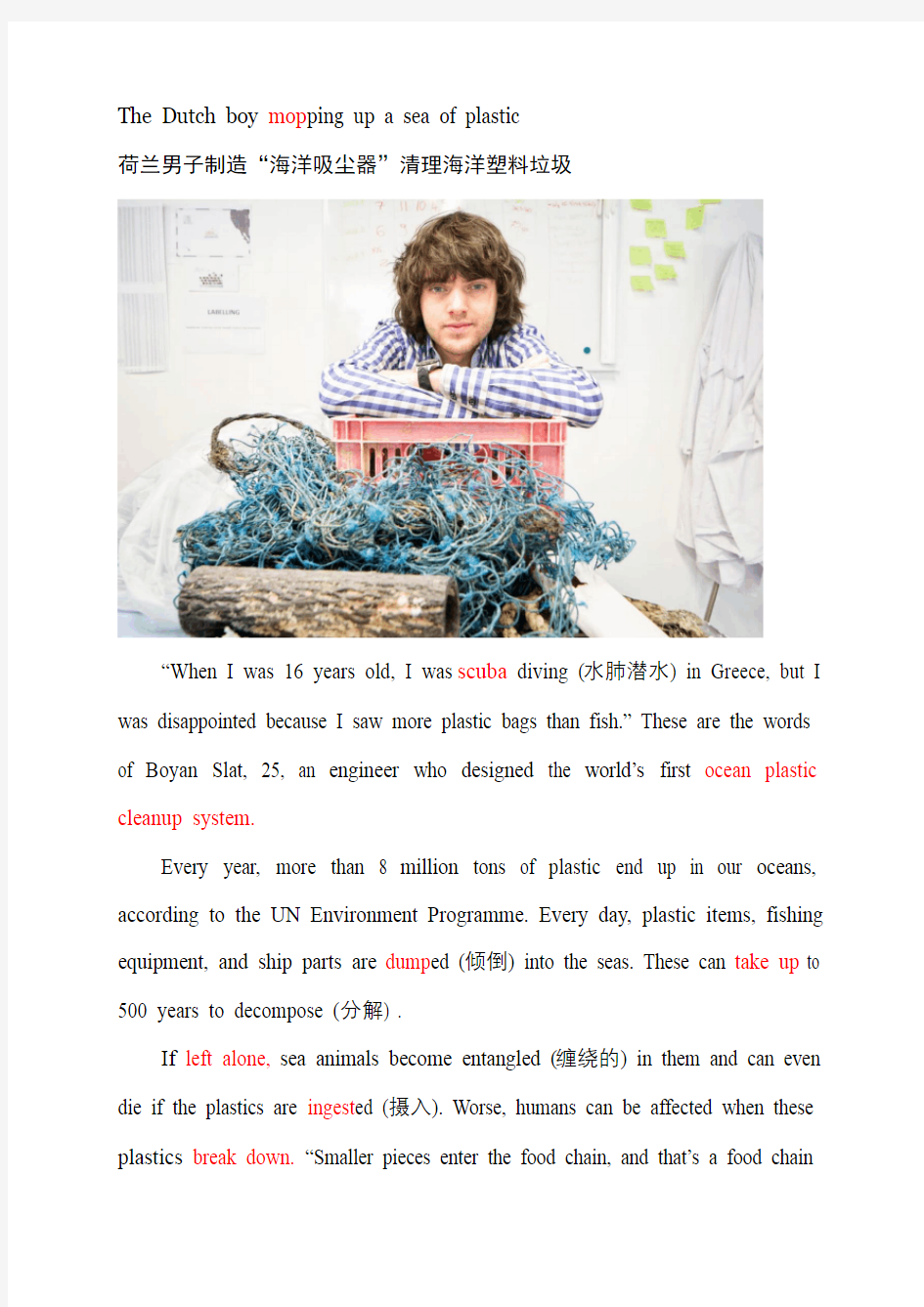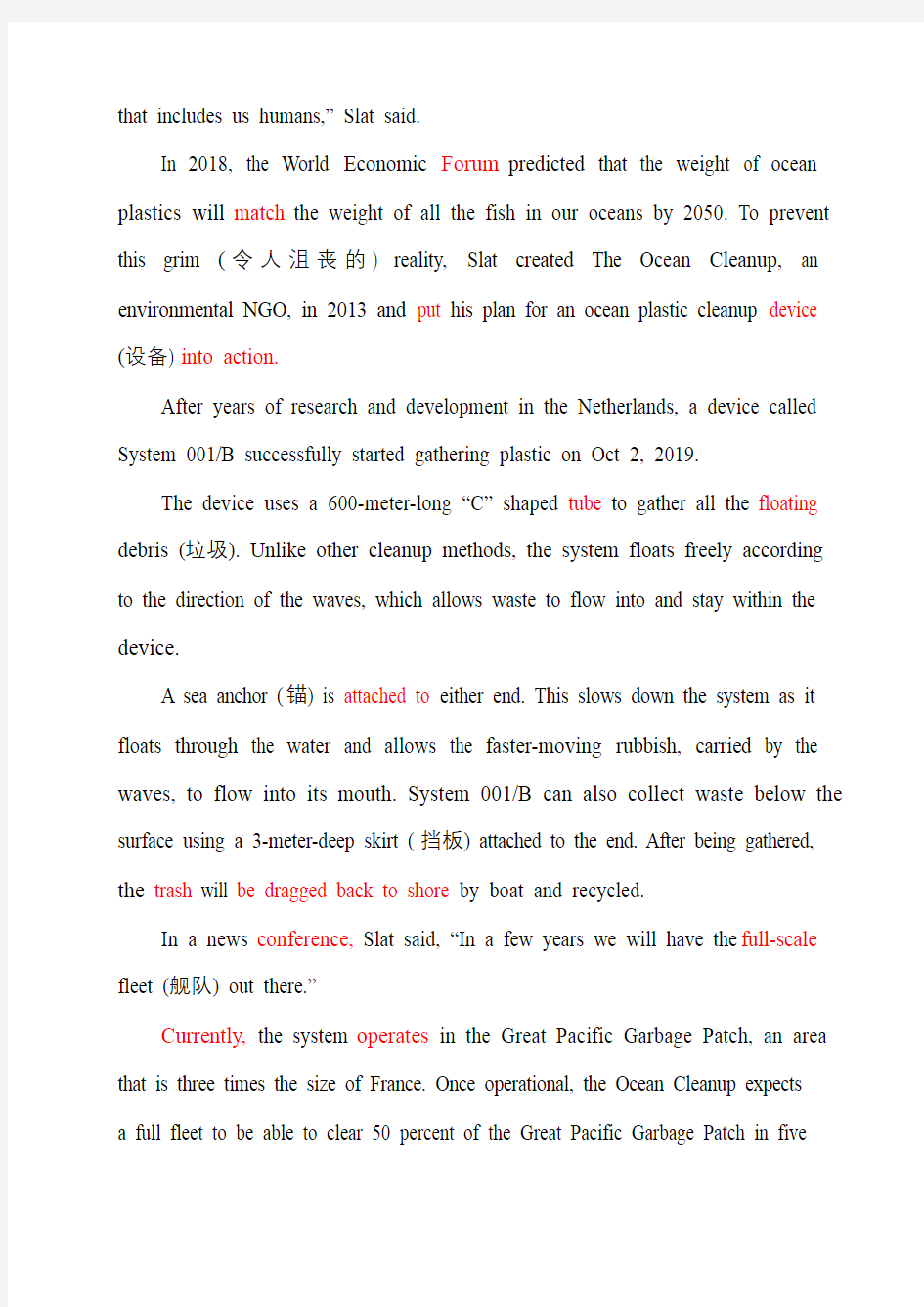2020年高考英语外刊时事命题阅读理解


The Dutch boy mop ping up a sea of plastic
荷兰男子制造“海洋吸尘器”清理海洋塑料垃圾
“When I was 16 years old, I was scuba diving (水肺潜水) in Greece, but I was disappointed because I saw more plastic bags than fish.” These are the words of Boyan Slat, 25, an engineer who designed the world’s first ocean plastic cleanup system.
Every year, more than 8 million tons of plastic end up in our oceans, according to the UN Environment Programme. Every day, plastic items, fishing equipment, and ship parts are dump ed (倾倒) into the seas. These can take up to 500 years to decompose (分解) .
If left alone, sea animals become entangled (缠绕的) in them and can even die if the plastics are ingest ed (摄入). Worse, humans can be affected when these plastics break down. “Smaller pieces enter the food chain, and that’s a food chain
that includes us humans,” Slat said.
In 2018, the World Economic Forum predicted that the weight of ocean plastics will match the weight of all the fish in our oceans by 2050. To prevent this grim (令人沮丧的) reality, Slat created The Ocean Cleanup, an environmental NGO, in 2013 and put his plan for an ocean plastic cleanup device (设备) into action.
After years of research and development in the Netherlands, a device called System 001/B successfully started gathering plastic on Oct 2, 2019.
The device uses a 600-meter-long “C” shaped tube to gather all the floating debris (垃圾). Unlike other cleanup methods, the system floats freely according to the direction of the waves, which allows waste to flow into and stay within the device.
A sea anchor (锚) is attached to either end. This slows down the system as it floats through the water and allows the faster-moving rubbish, carried by the waves, to flow into its mouth. System 001/
B can also collect waste below the surface using a 3-meter-deep skirt (挡板) attached to the end. After being gathered, the trash will be dragged back to shore by boat and recycled.
In a news conference, Slat said, “In a few years we will have the full-scale fleet (舰队) out there.”
Currently, the system operates in the Great Pacific Garbage Patch, an area that is three times the size of France. Once operational, the Ocean Cleanup expects a full fleet to be able to clear 50 percent of the Great Pacific Garbage Patch in five
years.
It remains to be seen if this dream will become a reality, but it is undeniable that humanity must work together to reduce our plastic use and repair the damage our waste has caused.
“We are starting to see a young generation that gets that and is excited about a sustainable (可持续的) future, but the question still comes down to: Are we going fast enough, and how much damage will have been done before we get there?” Slat said.
(节选自Telegraph)
1. What do the first four paragraphs mainly talk about?
A. Slat’s scuba diving experiences in Greece.
B. Slat’s research on ocean environments.
C. How ocean environment relates to humans.
D. How Slat got the idea for an environmental NGO.
2. What do we know about System 001/B?
A. It’s a cleanup device put into use last October.
B. It collects and recycles garbage at the same time.
C. It can only collect waste that floats in water.
D. It aims to clear the Great Pacific Garbage Patch in a decade.
3. What does Slat intend to tell us according to the last paragraph?
A. He is positive about the future of the ocean.
B. It is hard to repair the damage to the environment.
C. Humans should work hard to reduce plastic pollution.
D. The younger generation lacks environmental awareness.
译文:
“当我16岁的时候,我在希腊进行水肺潜水,但我感到失望的是,因为我看到的塑料袋比鱼还要多。”这就是25岁的博扬·斯拉特的话。第一个海洋塑料清理系统。
根据联合国环境规划署的数据,每年有超过800万吨的塑料最终进入我们的海洋。每天,塑料物品,捕鱼设备和船舶零件都被倾倒入海。这些可能需要多达500年的时间才能分解。
如果放任不管,海洋动物就会纠缠在其中,甚至在摄入塑料的情况下也可能死亡。更糟糕的是,当这些塑料分解时,人类会受到影响。斯拉特说:“更小的零件进入了食物链,这就是包括我们人类在内的食物链。”
在2018年,世界经济论坛预测,到2050年,海洋塑料的重量将与我们海洋中所有鱼类的重量相匹配。为防止这种令人沮丧的现实,Slat创立了环保非政府组织The Ocean Cleanup,在2013年将他的海洋塑料清理装置(设备)计划付诸实施。
在荷兰进行了多年的研发之后,一种名为System 001 / B的设备于2019年10月2日成功开始收集塑料。该设备使用600米长的“ C”形管收集所有漂浮的垃圾(垃圾)。与其他清理方法不同,系统会根据波浪的方向自由漂浮,从而使废物流入并留在设备中。
一个海锚附接到任一端。当系统漂浮在水中时,这会减慢系统的速度,并允许波浪携带的移动速度更快的垃圾流入其嘴中。系统001 / B还可以使用附着在末端的3米深裙边(挡板)收集表面以下的废物。收集后,垃圾将通过船拖回岸上并进行回收。
斯拉特在新闻发布会上说:“几年后,我们将拥有完整的舰队。”
目前,该系统在大太平洋垃圾场运行,该区域的面积是法国的三倍。一旦投入使用,海洋清理工作预计整个船队将能够在五年内清除大太平洋垃圾场的50%。
这个梦想是否会成真还有待观察,但是不可否认的是,人类必须共同努力减少塑料的使用并修复我们的废物造成的破坏。
“我们开始看到年轻的一代能够做到这一点,并对可持续的可持续发展感到很棒,但问题仍然归结为:我们的发展速度是否足够快,以及在我们获得成功之前将遭受多少损失?斯莱特说。
背景信息:
The plastic we use every day ends up in three main ways in the oceans:
Throwing plastic in the bin when it could be recycled
Plastic you put in the bin ends up in a landfill (填埋地). When transported to a landfill, plastic is often blown away because it’s so lightweight.
Littering
Litter dropped on the street doesn’t stay there. Rainwater and wind carry plastic waste into streams and rivers, and down drains (下水道). Drains lead to
the ocean.
Products that go down the drain
Many of the products we use daily are flushed (冲) down toilets and sinks, then out into the ocean.
我们每天使用的塑料最终会以三种主要方式进入海洋:
可回收利用的塑料被扔进垃圾箱中
您放入垃圾箱中的塑料最终被填埋了。运输到填埋场时,塑料通常很轻便,因此经常被吹走。
乱扔
垃圾乱丢在大街上的垃圾不留在那里。雨水和风将塑料废物带入溪流,河流和下水道。排水管通向大海。
排入下水道的产品
我们每天使用的许多产品都会冲掉马桶和水槽的水,然后排入大海。
单词:
affect v. 影响
同义词组:have an influence/effect on
辨析:effect n. 影响
例句:The change in climate may affect your health.
attach
vt. 系上,贴上
用法:attach sth to sth 使某物系在或附在另一物上
同根词:attachment n. 附件,连接物
例句:We attach labels to things before we file them away.
drag vt. 拖,拉
例句:Lisa managed to drag the table into the kitchen.
undeniable
adj. 不容置疑的
词缀:un-表示否定;-able表示"具有或显示……性质或特点的"例句:It’s undeniable that he has done a good job.
答案:1.D 2.A 3.D
